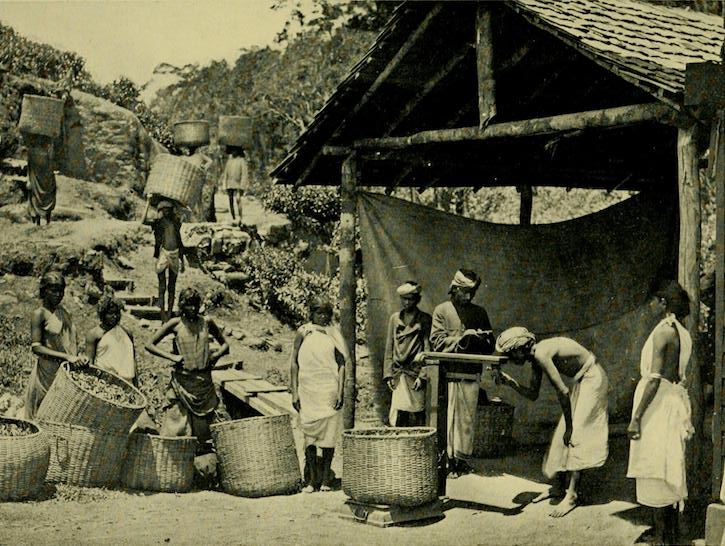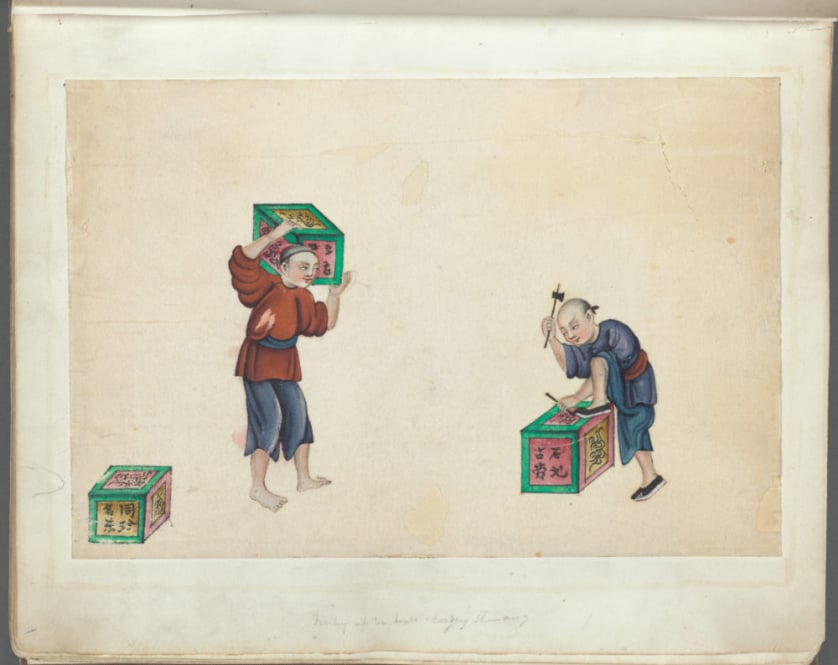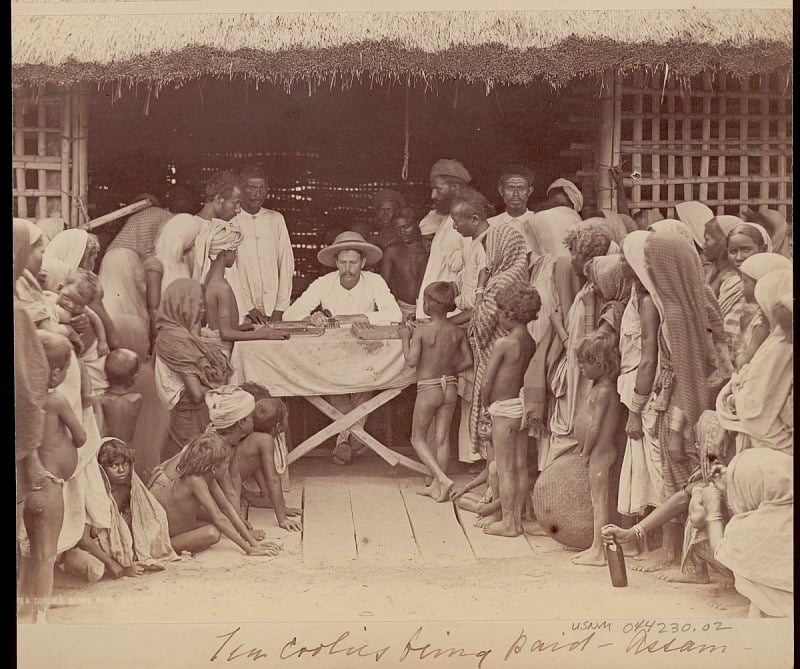Storm in a Teacup

Tea War: A History of Capitalism in China and India by Andrew B Liu. Yale University Press, 356 pages.
The casual observer of modern British history will know that long before tea became a mere driver of basic cognitive functioning in your average adult, it served as a class signifier. The highborn of British society in the eighteenth century, who first encountered tea as an exotic import from China, were forever alert to would-be symbols of their social superiority; caricatures from that period depict the elite at high tea gatherings sipping, savoring, and conoisseuring the stuff while the rest crudely ingested it. The middle and upper classes of Britain should be free to indulge themselves, the anonymous author of The Good and Bad Effects of Tea Consider’d wrote in 1745, but “persons of an inferior rank and mean abilities” ought to be denied tea’s stimulant effect.
Tea’s social role in Britain changed over time; it moved more and more into the mainstream of society as the decades passed. As the product was democratized, consumption grew from one-third of a pound per person at the middle of the eighteenth century to one and a half pounds by the middle of the nineteenth. Trade, largely the domain of the East India Company, expanded to meet that demand, so much so that, as the historian E.H. Pritchard wrote of that period, tea became “the God to which everything else was sacrificed.”
That is one story of tea. But there is a second, lesser known story that reveals, in a quite different—yet intimately connected—part of the world, another history of class, capital, and inequality. “It would be difficult to tell a history of modern capitalism in either China or India without considering the place of tea,” writes Andrew B. Liu in Tea War: A History of Capitalism in China and India. But the corollary to this statement, frequently pressed in the book, is equally inviting: it would be difficult to tell a history of modern capitalism without considering the place of China or India.
British, Dutch, and other European traders had been tapping Chinese plantations in Anhui, Fujian, and beyond since the 1600s. For as long as tea had remained a niche commodity, demand for it was steady. But as its popularity in Europe grew in the eighteenth century, and began to soar in the early nineteenth, the planters of coastal China were able to set increasingly high prices for tea, ushering in a golden age for the commodity. The British, unable to convince Chinese merchants to trade their tea for other British-imported products, resorted to smuggling in opium from India in order to accumulate the silver demanded. Two Opium Wars soon followed, after which foreign penetration of China—both economic and cultural—deepened. As one scholar quoted by Liu says, “there probably would have been no British Empire” without the triangular trade in opium and tea between Britain, India, and China.
Tea production in that region tells a story of transnational competition birthing capitalisms far outside of northwest Europe.
China’s supremacy in the tea trade began to waver in the late nineteenth century. This was because the British-run plantations of northeast India’s Assam region, which had taken root with the first tea garden in 1837, had expanded. Competition meant that prices for Chinese tea began to decline, and production was raised to meet growing demands. Workers, meanwhile, suffered. Old practices, in place for centuries, were repurposed for profit-seeking production by increasingly anxious Chinese merchants acting in the service of the Europeans. Peasant farmers who had once needed to roast, roll, and sift tea only at the pace required to meet a far lower global demand were now subjected to new ways of measuring and regulating the minutes, hours, and days spent on specialized tasks. The labor-intensive work of making tea was thus given added toil by the premium now placed on time, with the result that the “timed labor” essential to capitalist productivity in the West was simultaneously being seen in China.
As demand from Europe continued to rise and the rivalry with Assam deepened, Chinese planters, Liu writes, “exhibited social dynamics that belong squarely within the modern history of capitalism.” With an obsessive fixation on productivity, they “measured the amount of time needed for each task, designed instructions to minimize wasted activity, and used a piece-wage system to provide employees with incentives to work as hard as their bodies allowed.” One historian described the taxing new regime of labor that was pressed upon Chinese pickers in the face of ascendant Assam:
These pluckers sleep, at most, three to four hours each night. On days when the mountains are filled with mature leaves, the workers will go several nights without sleep. The bitterness of their lives can be called extreme.
Accounts from Chinese, and later, Indian, plantations across the eighteenth and nineteenth centuries provide a vehicle for understanding the role that transnational competition played in driving the divergent evolution of labor practices there. But for Liu, who teaches history at Villanova University, there was something else happening here. The popular framing of capitalism’s origin story—that it began in northwest Europe and then spread to the rest of the world—doesn’t hold up against a closer, more textured examination of plantation life in south and east Asia. In recent decades, researchers have become aware, he writes, “of the degree to which the world market relies upon patterns of accumulation that defy the original models.” Tea production in that region tells a story of transnational competition birthing capitalisms far outside of northwest Europe. To exclude the diverse socio-economic arrangements that evolved in India and China would, Liu quotes Jairus Banaji as saying, leave “large swathes of capitalism’s history unexplained and shrouded in mystery.”

The counter-narrative Liu provides, one that is deeply researched and admirably reasoned, requires that we decenter the West as the fount of the modern world’s dominant economic model. Excerpts from firsthand accounts of life on the plantations—and even from novels by Indian and Chinese writers—are used to animate the sometimes denser theoretical analysis he undertakes. The changing course of labor regimes on the Chinese plantations illustrates the increasingly ruthless means used by planters to organize and discipline the workforce so as to maintain their edge over Assam. But it is Liu’s sections on that corner of northeast India first encountered by colonial officers as “a jungle of gigantic reeds . . . pregnant with febrile miasma and death” that drive home the sheer brutality of the colonial project and its essential role in the early capitalist enterprise.
It was a Scot, Robert Bruce, whose sighting in 1823 of tea plants growing wild in the upper Brahmaputra Valley first alerted colonial administrators to Assam’s agricultural potential. Realizing the extraordinary gains to be made from dismantling China’s monopoly on the trade, the government quickly set about developing plantations there, and shipped its first consignment of Assam tea to London in 1838. By 1853, close to two hundred tons were arriving from India annually; three decades later, the figure stood at more than thirty-two thousand tons.
The penal contract system bound pickers to the plantation, and as the tea industry took flight, the parallels with chattel slavery in the American South grew starker.
With Assam holding the potential to overtake China as the leading tea-producing region of the world, and with tea now a vital part of the colonial economy, the plantations there had begun to function almost as mass breeding sites for Indian workers. British planters understood the benefit of recreating the conditions of village family life, and so they introduced aggressive pro-natal policies—maternity benefits, bonuses for bearing children—so that the plantation population would self-reproduce. Additionally, during the final decades of the eighteenth century, half a million migrants were brought in from central India to supplement the workforce. Pickers tended to be lower-caste, and their wages were fixed by law, meaning that as demand went up and work intensified (and profits for the colonists grew accordingly) their returns did not improve. The profitability of plantations was owed in no small part to the fact that their owners could pay pickers so little: at five rupees a month, their salaries were pathetic in comparison to free peasant agricultural workers elsewhere in Assam.
Liu quotes the conservative orientalist William Nassau Lees, a proponent of the emerging large-scale indentured labor system in Assam, who saw the Indian population as a feckless, easily coercible pool of hands that would, with a bit of nudging, deliver to Britain the capital it needed to keep its empire alive. “The natives of India are in a state of infancy,” Lees commented, and could be “enticed from their homes under delusions” to pick and process leaves from dawn until dusk. And so they were. The expansion of cheap, tightly controlled labor allowed British planters toward the end of the nineteenth century to open up an additional one hundred seventy thousand acres of plantation land. By the early 1900s, tea production in Assam had overtaken that of China, and had arguably become the largest private sector of British India, turning astronomical profits. “Competition in trade,” wrote Samuel Baildon, an Assam planter, “has become so keen—suicidal almost.”
All the while, British planters in Assam had been demanding the government of India pass legislation to tighten controls on the workforce, citing rising production expectations. From 1863 to 1882, a series of labor indenture laws were introduced that punished breaches of contract by employees as criminal acts. The penal contract system bound pickers to the plantation, and as the tea industry took flight, the parallels with chattel slavery in the American South grew starker. Pickers who absconded were hunted down by bands of “savage hillmen,” themselves paid five rupees for capturing a “runaway cooly” and returning him or her to the plantation—a practice legally enshrined in 1865. The whipping of errant or unproductive workers was common. Liu points to the work of the legal scholar Robert Steinfeld, who has argued that freer markets have actively produced regimes of unfree labor. “The story of Assam tea,” writes Liu:
Makes clear that metropolitan capital actively funded the rise of colonial labor indenture, much in the same way that recent literature has demonstrated how London and northern American banks funded southern United States slavery.
Metropolitan capital wasn’t the only force complicit in sustaining the labor regimes on the plantations. The profits coming from Assam were also a source of awkwardness for India’s increasingly vocal nationalist movement in the early twentieth century. Although the means by which those profits were being realized—namely, the brazen exploitation of hundreds of thousands of Indian workers—sat uncomfortably with so-called progressives, and indeed were resisted by many, the wealth generated by the trade would, they quietly knew, be valuable for the elites who inherited a newly independent country. “We were kept as hewers of wood and drawers of water; we were not allowed to develop our industries and we were exploited by our foreign masters for the benefit of their nationals,” the prominent nationalist Bipin Chandra Pal is quoted as saying. But, he adds: “Of the dark clouds of England’s exploitation, the brightest silver lining has been the tea industry, which is India’s fortunate legacy from foreign rule.” Even Gandhi, in whose name Assamese plantation workers went on strike in the early 1920s, vocally distanced himself from the strikers, and on one visit to the state met only with British planters. That continued a reluctance among his Congress Party’s leadership to engage with the sort of class-based agitation seen in Assam for fear that foreign capital would take flight.

Liu has written a richly edifying account of one, initially luxury, commodity’s outsized impact on international relations during a period that was pivotal in shaping the modern economic order. Tea War, which fits squarely within the ascendant “commodity history” genre, whereby the changing global status of one object is used to tell a grander story of humankind’s relationship to the world and to one another, is clearly targeted at an academic audience; passages that explore in fine detail, for instance, the economic histories of the two countries do risk losing the lay reader. Yet on the whole Liu skillfully telescopes in and out, from examination of the local experiences of plantation workers in India and China to elaboration of the book’s central argument: we lose so much in our understanding of how the economic model that rules the day came about if we remain siloed in an Anglocentric, technicist viewpoint.
Like the tea plantations of old, fierce competition to maintain contracts with clients in the West sees the economies of Asia engaged in a perennial race to the bottom.
The problem with the canonical interpretation of capitalism’s origins isn’t only that it privileges the West. Rather, it’s that it simultaneously devalues and dismisses, without proper examination, all that goes on outside of the West. We have come to know capitalism’s early life as “equated with a high level of technological sophistication and a specific set of class relations founded upon free labor and first located within England,” Liu states. But the changing faces of labor and capital in India and China that came about as competition for supremacy in the tea trade intensified tell a different story. There was no industrial revolution there, no mechanized production and, at least until later reforms, no free labor. Rather, the two countries demonstrate how “both purportedly independent peasant households in China and unfree indentured workers in India, regardless of levels of mechanization, produced economic value as part of a circuit of capital accumulation spanning the globe.”
Assam’s supremacy didn’t survive the twentieth century. China is now the world’s largest producer of tea, turning out over two million tons each year. And while Britain’s appetite for the drink hasn’t diminished, China’s has grown—a significant portion of its output now goes towards slaking the thirst of its own middle class. The same is true of India. Nor is there much tolerance these days for tea produced by exploited workers. With the mainstreaming of Fairtrade and other standards, pressure on planters to improve conditions for pickers has led to some enhancement of workers’ rights.
But as Tea War makes clear, certain things do hold. Two centuries ago, the tea regions of northeast India, and to a lesser extent, China, had been vital to keeping the economies of expansionist European nations afloat. That relationship of dependency hasn’t changed, with Asia today responsible for the lion’s share of the world’s manufacturing. Estimates of the number of employees working at just one Chinese manufacturing plant—that of Foxconn in Shenzhen, which supplies products for Apple, among others—range from anywhere between two hundred thirty thousand to four hundred fifty thousand.
W.E.B. Du Bois knew of a “dark and vast sea of human labor in China and India, the South Seas and all Africa . . . on whose bent and broken backs rest today the founding stones of modern industry.” The labor force he wrote of nearly a century ago remains, albeit now hidden behind factory walls. There, men and women, many of them migrants, work long shifts in endless rows under strip light to produce volumes upon volumes of iPhones and other once-luxury, now-necessary commodities for sale overseas. Like the tea plantations of old, fierce competition to maintain contracts with clients in the West—a competition won by the wholly inhumane calculus of increased productivity for decreased wages, and abetted by political leaders who demonstrate little regard for vulnerable workers—sees the economies of Asia engaged in a perennial race to the bottom.
“Capital,” Marx famously stated, “comes dripping from head to foot, from every pore, with blood and dirt.” Writing a century and a half ago, he had one eye on Europe and another on the colonies, but the same is as true today as it was then. Accounts of the harshness of life on the plantations are discomfortingly similar to those from the factories of the twenty-first century. Capitalism, to give it its due, is at least consistent.